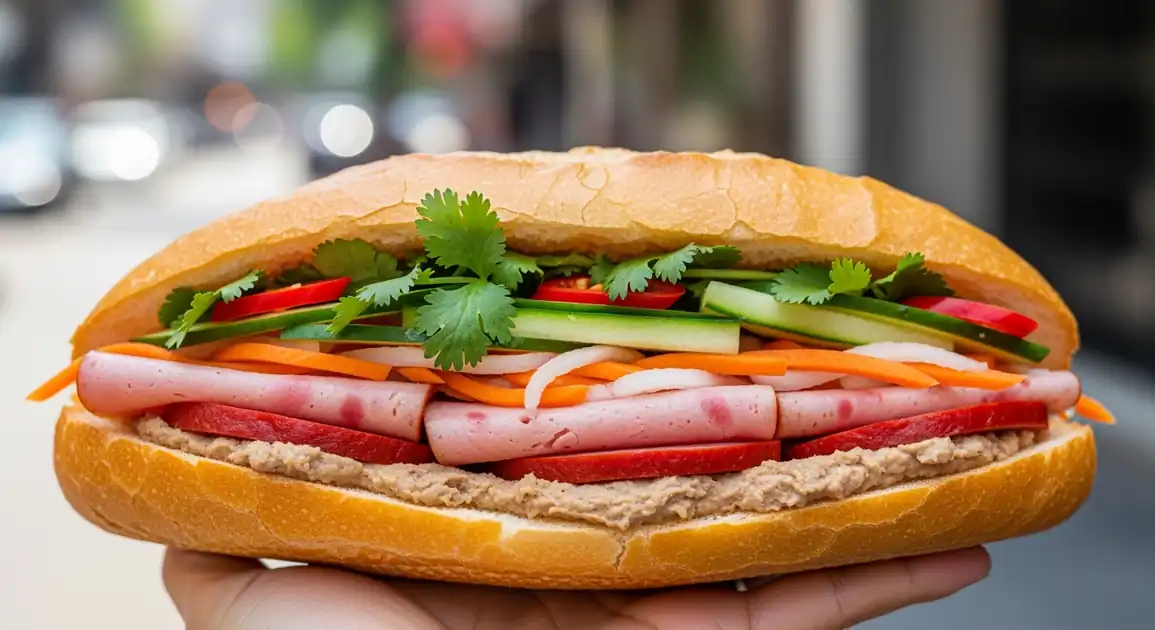Bánh mì (Vietnamese Baguette Sandwich)
Bánh mì

Description
Da Nang offers a solid Bánh mì scene, influenced by both Northern and Southern styles but with its own Central Vietnamese characteristics. You'll find classic options alongside local specialties like Bánh mì bột lọc. It's generally less internationally hyped than Hoi An but offers excellent quality and value.
Dietary Information
Serving information
Serving style
Standard paper wrapping. Fillings might include local specialties. Spice level is usually adjustable upon request.
Quick facts
Similar to Hanoi, predominantly morning (6 AM - 10 AM) and afternoon/evening (3 PM - 10 PM).
Safety Tips
What to Look For
-
Fresh, crispy baguette
Bread should be light with a crisp crust, not stale or chewy. Often kept warm or toasted quickly before assembly.
-
Clean preparation area and utensils
Look for clean cutting boards (separate for meat/veg ideally), knives, and vendor hands/gloves. Avoid vendors with visibly dirty setups.
-
Fresh-looking pickles (đồ chua) and herbs (cilantro)
Pickles should be brightly colored and crisp, herbs should be vibrant green and unwilted. Indicates fresh ingredients.
-
High customer turnover
Busy stalls mean ingredients are used quickly and replenished often, reducing the time fillings sit out.
-
Proper handling of ingredients
Vendor uses tongs, gloves, or clean hands, avoids cross-contaminating ingredients (e.g., touching money then food).
-
Pâté and mayo look fresh
Observe the texture and color; avoid if they look discolored, dried out, or stored improperly in heat.
What to avoid
-
Stale or soft bread
Significantly detracts from the Bánh mì experience and may indicate the vendor isn't focused on quality.
-
Wilted herbs or dull-looking pickles
Suggests ingredients are not fresh, impacting flavor and potentially safety.
-
Fillings left uncovered and exposed for long periods
Increases risk of contamination from dust, insects, and bacterial growth, especially for pâté and meats.
-
Visible signs of poor hygiene
Dirty cart, cloths, utensils, or vendor practices (e.g., no handwashing) are red flags.
-
Re-using oil for fried elements (like ốp la)
If getting a Bánh mì with fried elements (like egg), ensure the oil looks reasonably clean.
Price information
Price range
Budget tips
- Street stalls offer excellent prices (15,000-25,000 VND).
- Look for vendors near local schools or markets for the best deals.
- Prices are generally lower than in major tourist hubs like Hoi An's center or HCMC's District 1.
Value indicators
- Good bread quality - crispy crust is key.
- Flavorful local fillings like chả bò (beef sausage).
- Fresh ingredients and balanced flavors.
- Good value for money.
Where to Find This Dish
Near Han Market
The area around this central market has numerous food stalls, including Bánh mì.
Chợ Hàn (Han Market), Dragon Bridge (Cầu Rồng) vicinity
Morning, Afternoon
Hoàng Diệu Street Area
Known for several popular local eateries and street food stalls.
Streets branching off Hoàng Diệu
Morning, Evening
University Areas
Around Da Nang University campuses, find affordable and tasty options.
University of Da Nang buildings
Morning, Lunch
Vendor Tips
- Ask for local specialties like Bánh mì with 'chả bò' (beef sausage) if available.
- Look for stalls grilling 'thịt nướng' fresh - the aroma is a good sign.
- Confirm spice level as Central Vietnamese cuisine can be quite spicy.
- Explore side streets for potentially less crowded, authentic local vendors.
How to Order
Regional Variations
-
Bánh mì Chả Bò
(Bánh mì Chả Bò)
Features slices of flavorful Da Nang-style beef sausage (Chả Bò), often slightly spicy and seasoned with black pepper.
-
Bánh mì Bột Lọc
(Bánh mì Kẹp Bột Lọc)
A unique Da Nang variation where chewy tapioca dumplings filled with shrimp and pork ('bánh bột lọc') are added inside the baguette, sometimes with a special sauce.
-
Spicier Profile
(Vị Cay)
Central Vietnamese cuisine is known for its spiciness, which can sometimes carry over into the Bánh mì sauces or chili used.
Cultural context
History
The baguette was introduced to Vietnam by the French during the colonial period. Initially, it was eaten simply with butter or pâté. After the French withdrawal in 1954, Vietnamese vendors adapted the sandwich, adding local ingredients like Vietnamese cold cuts (chả lụa), pickled vegetables, herbs, and sauces, transforming it into the Bánh mì we know today. It became an affordable and popular staple food, evolving with distinct regional variations across North, Central, and South Vietnam.
Local significance
A convenient and beloved everyday food for Da Nang residents. Reflects the Central Vietnamese preference for balanced flavors, sometimes with notable spiciness.
Eating customs
- Typically eaten handheld, soon after purchase.
- Less emphasis on international fame compared to Hoi An, more of a local staple.